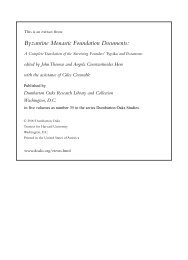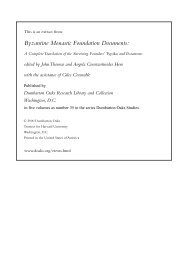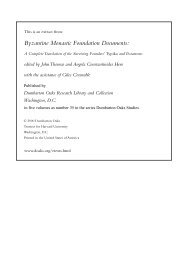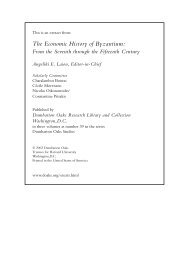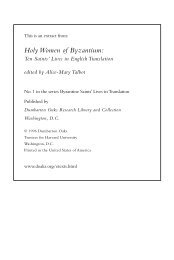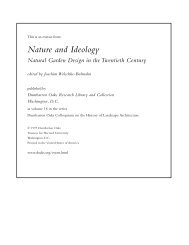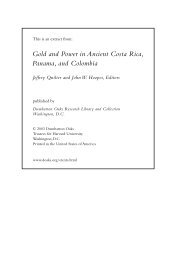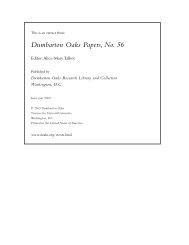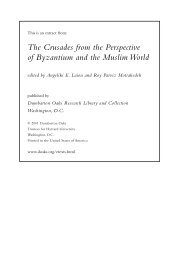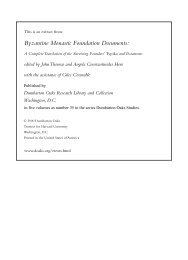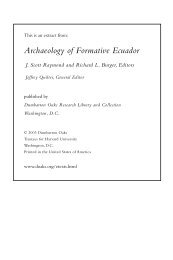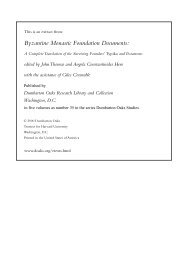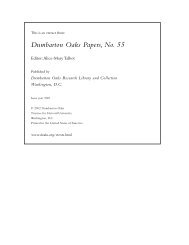22. Evergetis - Dumbarton Oaks
22. Evergetis - Dumbarton Oaks
22. Evergetis - Dumbarton Oaks
You also want an ePaper? Increase the reach of your titles
YUMPU automatically turns print PDFs into web optimized ePapers that Google loves.
ELEVENTH CENTURY<br />
<strong>22.</strong> <strong>Evergetis</strong>: Typikon of Timothy for the Monastery<br />
of the Mother of God <strong>Evergetis</strong><br />
Date: First edition, 1054–70;<br />
periodically revised later; put in final form, 1098–1118 1<br />
Translator: Robert Jordan<br />
Edition employed: Paul Gautier, “Le typikon de la Théotokos Évergétis,” REB 40 (1982), 5–101,<br />
with text at 15–95.<br />
Manuscript: Codex Atheniensis, National Library 788 (12th c.) 2<br />
Other translations: French, by Gautier, REB 40 (1982), 14–94.<br />
Institutional History<br />
A. The First Founder, Paul Evergetinos, and His Works<br />
According to the document translated below, the monastery of the Mother of God <strong>Evergetis</strong>, “Benefactress,”<br />
was founded [2] by a certain Paul, a wealthy Constantinopolitan, on an estate (proasteion)<br />
that he had acquired through a family inheritance. The foundation occurred in either 1048 or 1049,<br />
on this suburban property outside the walls of Constantinople. According to our document, the<br />
foundation was very modest [3] during Paul’s five-year tenure as superior, consisting of some<br />
small cells inhabited by a few disciples, including Paul’s eventual successor Timothy, who joined<br />
[2] <strong>Evergetis</strong> in 1049.<br />
As it transpired, Paul Evergetinos’ legacy to Byzantine monasticism was primarily literary.<br />
He was the author of a massive ascetic florilegium, the Evergetinon, which enjoyed a wide circulation<br />
in the Byzantine world, surviving in no less than forty manuscripts today. 3 The work is<br />
divided into four volumes, each of which is subdivided into fifty hypotheses. The first volume<br />
concerns itself with the general principles of monastic asceticism, the second with monastic usages<br />
and the requirements of cenobitic life, the third with personal morality, and the fourth with<br />
progress in the spiritual life. The author’s emphasis is on the practical aspects of monastic life. He<br />
relies on a fairly short list of sources, using the Apophthegmata Patrum most of all, for which the<br />
Evergetinon is one of the most important textual witnesses. There is hardly any use of Basil of<br />
Caesarea. According to Richard (“Florilèges,” col. 503), Paul does not hesitate to adapt some of<br />
his texts to suit his own purposes, but generally he cites them literally. The Evergetinon may have<br />
inspired two later ascetic florilegia by Nikon of the Black Mountain, author of (20) Black Mountain<br />
and (21) Roidion, and by John of Antioch, both of whom were important monastic reformers<br />
in their own right. 4 As Solignac notes (“Paul Évergétinos,” col. 563), the work is so large that it is<br />
difficult to see how Paul could have completed it during the relatively short term of his superiorship<br />
at <strong>Evergetis</strong>, yet he also assembled a collection of monastic catecheses, utilizing works of Maximos<br />
the Confessor, Pseudo-Makarios, Evagrios Pontikos, Mark the Hermit, and the Great Catecheses<br />
of Theodore the Studite. 5<br />
[ 454 ]




